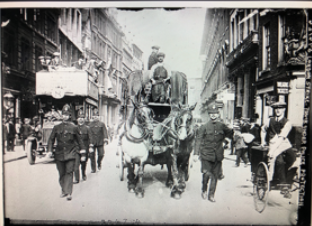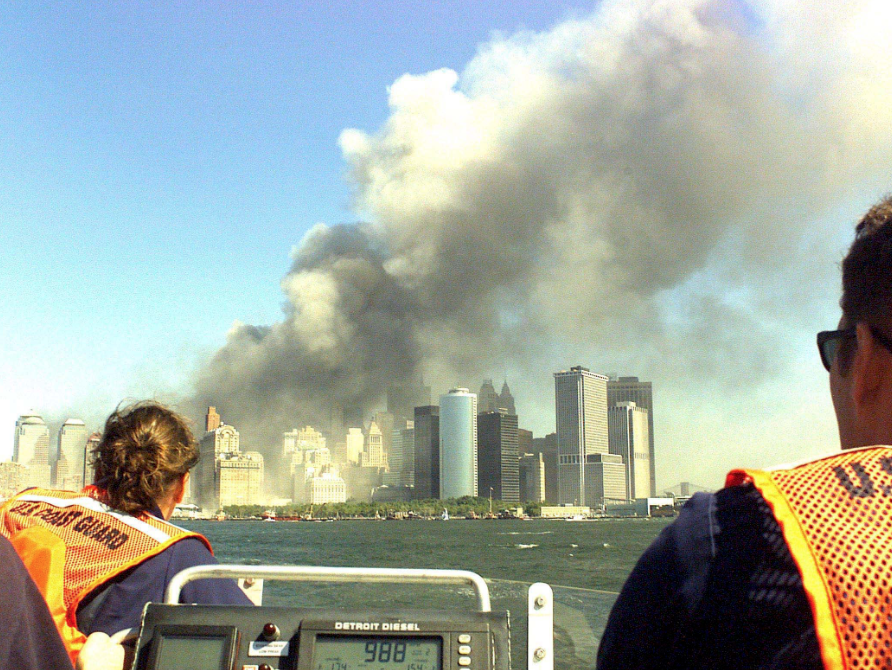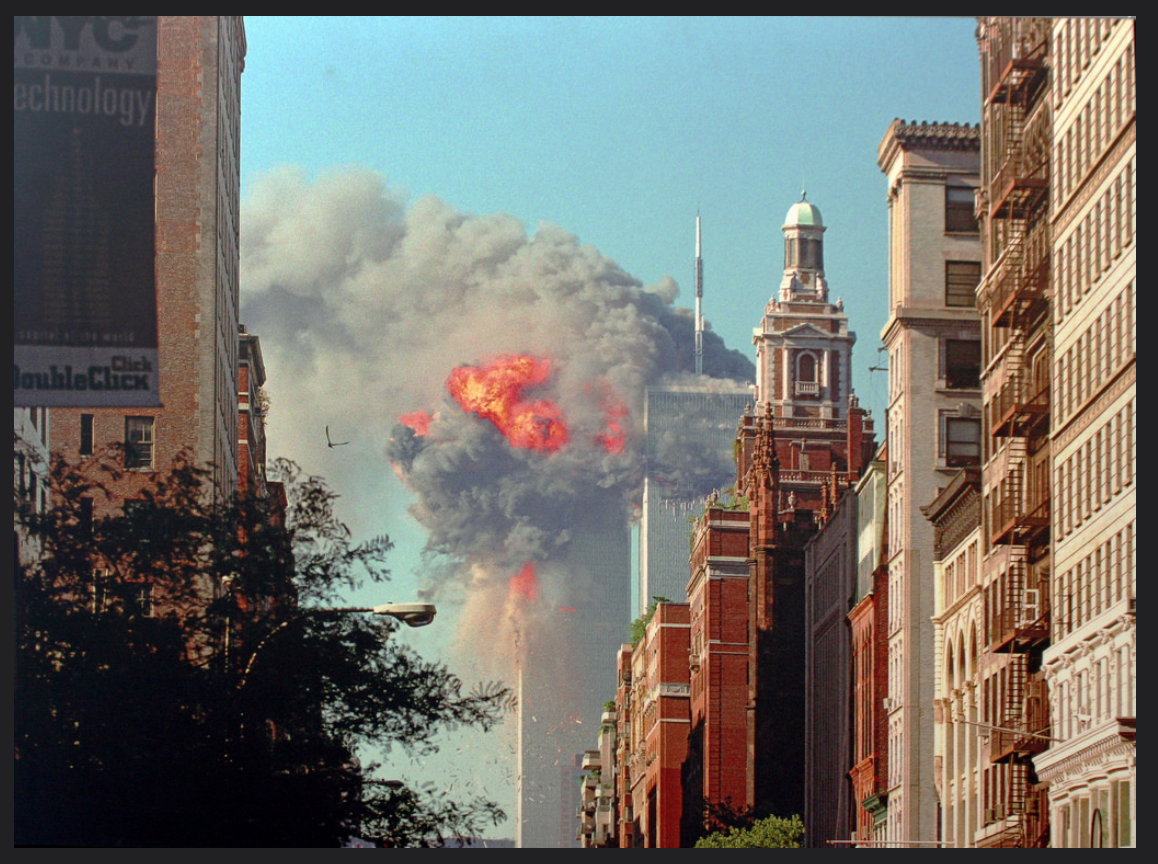6.3. Policing Eras
Tiffany Morey
Researchers Kelling and Moore (1991) evaluated the first three eras of policing. These eras are discussed below and are often referred to as the Political Era, the Reform Era, and the Community Era. Through the microscope of seven topical areas, listed below, an understanding of how policing evolved begins.
- Authorization
- Function
- Organization
- Demand
- Environment
- Tactics
- Outcomes
These seven characteristics have been used to evaluate how policing operated throughout history, most notably through its organizational structure, tactics, and primary focus. [1]
Political Era: The political era is often referred to as the first era of policing in the United States and it began around the 1840s with the creation of the first bona fide police agencies in America [2]
This era of policing is marked by the Industrial Revolution, the abolishment of slavery, and the formation of large cities. One way to confirm the start of this era is to look at the creation of police departments in larger cities:
- New York Police Founded 1845
- Chicago Police was Founded in 1855
- Philadelphia Police was Founded in 1751
- Jacksonville Police Founded 1822
- Indianapolis Police Founded 1850’s
- Detroit Police was Founded in 1865
- Portland Police was Founded in 1870
- Eugene Police was Founded in 1863
- Jackson County, Oregon Police Founded 1852
With the advent of the industrial revolution, came goods and services. Along with new job opportunities, came a myriad of conflicts as well. The fast-growing cities had to answer these problems with solutions in the form of policing. The abolishment of slavery and the newly free black population created many unforeseen issues too with The Ku Klux Klan. The Klan began to make terrifying appearances and their reign of terror left many in fear. Policing had not yet formally entered the scene; therefore, The Klan operated virtually unencumbered.

The United States saw tremendous growth in major cities, had the Industrial Revolution, and abolished slavery, which is when the Political Era of policing was set into motion. As its name suggests, it was an era of politics, mainly because of how policing was limited as a result of new laws, made clear by the Constitution. America answered the call by following the English and Sir Robert Peel’s principles. Not unlike today, policing during this era was under the control of politicians. Politicians, like the mayor, had no problem controlling everything a policeman did during his call of duty (NOTE: the word policeman/men is utilized in this era/context, because during this period, women were not allowed in the profession, and if they were accepted it was under a microscopic view of certain stereotypical matronly duties to be performed). Black policemen were rarely hired. Black policemen made their way into policing in the late 1800s, but when the Civil Rights Act of 1875 was ruled unconstitutional, Black officers all but disappeared from policing until the 1950s.
1957 annual wage for a police patrolman – Milwaukee Police Department: $5,405.40
2018 annual wage for police patrolman- Milwaukee Police Department: $57,291.00
Reform Era: Because the Political Era of policing ended up being laced with corruption and brutality, the panacea for the negativity became the Reform Era. One police chief was largely at the forefront of this new era, Chief August Vollmer. He is considered the pioneer of police professionalism. August Vollmer was the Chief of Police in Berkeley, California (1905-1932). He had many new beliefs about policing that would forever change the world of policing:
- Candidates who were tested to be in policing had to undergo psychological and intelligence tests
- Detectives would utilize scientific methods in their investigations, through forensic laboratories
- Recruits, for the first time, would attend a training academy (police did not receive any formal training before August Vollmer’s arrival)
- Assisted with the development of the School of Criminology at the University of California at Berkeley
Chief August Vollmer saw policing and officers as social workers that needed to delve into the causes behind the acts to solve the issue, instead of just arresting it. [3] He knew to rehabilitate offenders, police officers needed to look behind the handcuffs and start looking into the person and reason behind the behavior. [4]

Diversity in policing started to make a mark during this era, but it would fall irrevocably far from meeting any type of quota. It was a better era for diversity than the Political Era, but the numbers don’t lie in that it fell dismally short.
The Community Era- 1980s to 2000: In the 1960s and 1970s the crime rate doubled and it was a time of unrest and eye-opening policing issues. Civil rights movements spread across America and the police were on the front lines. Media coverage showed controversial contact between white male officers and African American citizens, which further irritated race relations in policing. The U.S. Supreme Court handed down the landmark Miranda v. Arizona and Mapp v. Ohio decisions. The writing was on the wall that the policing environment had to change. The days of answering everything with bullying or police professionalism were no more. The Community Era of policing began and those in police administration hoped this new era held the answers to fixing decades-old issues. The police needed help and they would turn towards the community and its citizens for assistance.
This new era of community policing held that police couldn’t act alone; the community must pitch in as well. Whether the problems were a dispute between neighbors or high crime area drugs and shootings, these issues did not develop overnight and could not be solved by a response of police alone. Instead, these community problems needed a pronged approach where the police worked together with the community, and over time the issues could be systematically solved. Out-of-the-box thinking was common in community policing and often community leaders were identified to make an impact. During this time police candidates started showing up to the application process with Associates and Bachelors degrees. The ‘old school officers’ mocked these degree-holding candidates. But the landscape was changing and officers needed more thorough training than ever to answer the call.
Problem-oriented policing was an after-effect of community policing, in that it utilized community policing, but focused on the problems first. The biggest difference was that problem-oriented policing used a defined process for working towards the solution. The problem was torn apart layer by layer and rebuilt according to set parameters that have a proven record of working.
The Community Era was also a time for research. Before this era, research on crime, police, or criminal justice topics was few and far between. With new federal government funding options available, this era’s missions could be accomplished through grants and the needed research began. Proof of what worked, and what didn’t, and suggestions on how to improve policing were abundant. Without research or studies, policing can become stagnant. But with funding available, the answers were a questionnaire or interview away and solutions came rolling in.
Community Era Example
“I remember the Community Era very well. I was a new police officer during this time and actually at the forefront of Community Policing and Problem-Oriented Policing. I was the first woman officer at my police department that was pregnant and the administration was open to suggestions when asked what to do with me when my belly expanded. I politely suggested that once I was five to six months pregnant and began to show (and not fit in my uniform or patrol belt anymore), I would be voluntarily transferred to the Crime Prevention Division. With my doctor approving this decision, my belly grew, and I transferred to this new division. I remember hitting the streets and knocking on doors, spewing how great of a panacea Community Policing was. It took some buy-in and with the citizens who ‘bought it,’ the concept became a reality and worked! Months later we had a string of burglaries occurring in a high-crime neighborhood. The detectives, patrol, and everyone hit the streets, knocking on doors, and questioning everyone, in an attempt to find the criminals responsible. To no avail, I turned to Community Policing. I brought in a mounted police officer and a horse. My colleagues chucked and shook their heads in response! What was I thinking?!?! “It was a waste of resources,” they balked! How could a cop on a horse solve this crime? I was glad; I ‘wasted my time,’ because it worked! The officer on the horse brought citizens out of their houses who normally would never have spoken to a police officer. The horse was such a spectacle in the neighborhood, that it was the catalyst that caused citizens to not only come out of their houses but to start talking about what and who they had been seeing in and around their neighborhood that did not belong. One such sighting was a vehicle description, which led to criminals responsible for the burglaries. ”
The Homeland Security Era- 2001 to Present: On September 11th, 2001, when terrorists hijacked airplanes and flew them into the World Trade Center buildings and Pentagon in the United States, a fourth era of policing, the era of Homeland Security, was said to emerge. [5] The long-lasting repercussions of this terrorist act would forever change life for Americans, and the daily activities of all policing departments. There is some debate in the field as to the order of policing eras and what they should be called. Some scholars list the policing eras as:
- Pre-Policing Era
- Political Era
- Reform Era
- Community Era
While others believe the policing eras are:
- Political Era
- Reform Era
- Community Era
- Homeland Security Era
The realities of the tragedy of 9/11 were that it did start a new era of policing. A case could be made for the large dark line that became metaphorically visible on 9/11/01 when the Community Era shifted to the Homeland Security Era as airplanes destroyed America’s feelings of safety. Policing will probably always involve some sort of Community Era policing to make a difference.

Policing under Homeland Security is marked by a more focused concentration of its resources on crime control, enforcement of criminal law, traffic law, etc., to expose potential threats and gather intelligence. [6]
Scholars have examined the pros and cons of a national police department in the United States. For example, Canada has a Royal Canadian Mounted Police. Whereas, depending on location, one could go through several different cities and counties while driving to the store, all of which have their respective police departments. With the advent of the Homeland Security Era, a new model of centralized organizational control began due to the need for information dissemination. One of the biggest flaws of 9/11 was the lack of communication between law enforcement agencies. The Department of Homeland Security was developed and one of its first major missions became the dissemination of information and communication. So, while a national police department does not exist in the United States, communication and information are now a common thread that binds all of the different types of law enforcement agencies.

Homeland Security Era Examples
I remember I awoke to a live video showing one of the World Trade Center buildings with smoke billowing from the windows. I wondered hesitantly how the fire started. Then, as one video camera rolled, by happenstance, it caught an airplane flying directly into the Second World Trade Center building and my worst fears came true. I think I stumbled to the edge of my couch and steadied myself, although I don’t remember, as I watched what happened next, slowly unfold. The effects of that day will never be forgotten.
During a trip to New York, last summer, I visited the World Trade Center museum. As I walked through the halls, a pin drop could have been heard. The respect, sadness, and overwhelming feelings that filled me made it difficult to breathe. Not only did the terrorists kill and destroy many things that day with their hate but they forever changed policing. I was a patrol officer at the time when the devastation ravaged America. Sadness filled our department for our brothers and sisters who lost their lives. We didn’t realize at the time, but our departments and thousands of others in policing across America were in for major changes, because of the heinous acts of a few. The first changes I remember taking place were: Active shooter updates and training; Incident Command System (ICS) updates and training; NEMA emergency management training; Gas masks were distributed for each officer, to be carried full-time, along with 3-month re-check and applicable training; Policy and procedure updates and additional response training depending on the call type; Reconfiguration of call type and responses to each; COMMUNICATION became the center of everything.
It became essential to hire a person to go through all the communication and alerts we received daily and alert those the information affected Unless those in the policing field had blinders on, the era of Homeland Security, was probably at the time, and will probably always be, one of the most substantial in policing history.
- Greene, J. R., & Mastrofsky, S. D. (Eds.) (1991). Kelling, G.L., & Moore, M. H. (1991). From political to reform to community: The evolving strategy of the police. In Community Policing: Rhetoric or Reality. New York: Praeger. ↵
- Oliver, W. M. (2006). The fourth era of policing: Homeland Security. International Review of Law, Computers & Technology ↵
- Reppetto, T.A. (1978). The Blue Parade. New York: Free Press. ↵
- Reppetto, T.A. (1978). The Blue Parade. New York: Free Press. ↵
- Oliver, W. M. (2006). The fourth era of policing: Homeland Security. International Review of Law, Computers & Technology. ↵
- Oliver, W. M. (2006). The fourth era of policing: Homeland Security. International Review of Law, Computers & Technology. ↵

